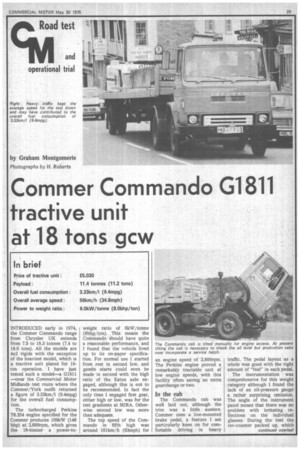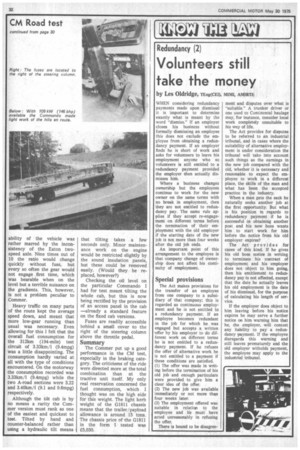Commer Commando G1811 tractive unit at 18 tons gcw
Page 39

Page 40

Page 42

If you've noticed an error in this article please click here to report it so we can fix it.
INTRODUCED early in 1974, the Commer Commando range from Chrysler UK extends from 7.5 to 18.3 tonnes (7.4 to 18.0 tons). All the models are 4x2 rigids with the exception of the heaviest model, which is a tractive unit plated for 18ton operation. I have just tested such a model—a G1811 —ove.r the Commercial Motor Midlands test route where the Commer/York outfit returned a figure of 3.33km/1 (9.4mpg) for the overall fuel consumption.
The turbocharged Perkins T6.354 engine specified for the Commer produces 109kW (146 bhp) at 2,600rpm, which gives the 18-tonner a power-to weight ratio of 6kW/tonne (8bhp/ ton). This means the Commando should have quite a reasonable performance, and I found that the vehicle lived up to its on-paper specification. For normal use I started from rest in second low, and gentle starts could even be made in second with the high ratio of the Eaton axle engaged, although this is not to be recommended. In fact the only time I engaged first gear, either high or low, was for the test gradients at MIRA. Otherwise second low was more than adequate.
The top speed of the Commando in fifth high was around 101km/h (63mph) for an engine speed of 2,600rpm. The Perkins engine proved a remarkably tractable unit at low engine speeds, with this facility often saving an extra gearchange or two.
In the cab
The Commando cab was well laid out, although the trim was a little austere. Commer uses a low-mounted brake pedal, a feature I am particularly keen on for comfortable driving in heavy traffic. The pedal layout as a whole was good with the right amount of "feel" in each pedal.
The instrumentation was comprehensive for this weight category although I found the lack of an oil-pressure gauge a rather surprising omission. The angle of the instrument panel meant that there was no problem with irritating reflections on the individual glasses. During the test the rev-counter packed up, which I found more of a nuisance than I would have expected owing to the high noise level of the Perkins power unit. The engine note did not alter very much from 2,000rpm upwards all the way to 2,600rpm.
The noise level of the engine was one of the disappointments I found with the Commando. On a trailing throttle or at part load, the in-cab noise level was reasonable if not outstanding. Opening the throttle increased the noise level out of all proportion in spite of the noise-shielding that Commer has added around the engine.
I cannot conclude a report on the Commer cab without mentioning the visibility. Forward visibility both in the wet and in the dry was first class, but this was spoilt by the poor vision to the rear. The mirrors on the Commer are tall and narrow, and I found it impossible to adjust them to give a wide enough field of vision, with the result that I was forever craning my head when going around corners to see where the trailer axle was— and with a single-axle 40footer that was a serious problem.
Ride and handling
Any comments that I noted about the ride and handling of the Commer refer more to the trailer than the tractive unit. The G1811 was supplied for test coupled to a single-axle York flat platform trailer 12m (39ft 3in) long—not the most suitable combination for the CM Midlands circuit. In fact, at many stages on the route I had to bring the vehicle speed right down to give me sufficient space to wind the trailer in and out of the parked cars.
I felt that the ride of the combination was poor, but again I think this was attributable to the trailer rather than the tractive unit. On one section of the route near Stratford the Commer cab started rocking severely when crossing a bad stretch of road but, looking in the mirror, I could see the long platform of the trailer flexing in the middle, which meant that at certain frequencies the drive axle was being bounced almost off the ground.
In general I liked the steering of the Commer. This particular model was fitted with power steering (the last Commando tested by CM was severely criticised for mit being so fitted), which meant that the extra manoeuvring required because of the trailer could be carried out without a great deal of physical effort on the part of the driver. In the straight-ahead position, however, I found the steering a bit too vague for comfort with more correction being required than I would like.
The Commando really excelled itself in the braking tests. Both in the full-pressure stops at MIRA and on the road the air/hydraulic system showed up well. In the crash stop from 40mph, for example, the Commer stopped in less than 90ft with an average deceleration of 0.62g. The steering pulled slightly to the right during the heavy stops, but this did not cause any great concern—only about half a turn was necessary to hold the vehicle. This pulling tendency was not apparent on the road part of the test and there I had complete faith in •the Commer's stopping ability.
Having criticised the parking brake control location of many trucks in the past, it is nice to be able to redress the balance slightly. The Commer had the control situated just where the hand fell on it naturally to the right of the driver's seat—no problem with getting in the way of the gear lever as when •the control is on the driver's left.
Hill performance
The power of the Perkins engine meant that none of the hills on the route gave the Commer any trouble—even the notorious Fish Hill climb out of Broadway. The hill-climbing ability of the vehicle was rather marred by the inconsistency of the Eaton twospeed axle. Nine times out of 10 the ratio would change quickly without fuss, but every so often the gear would not engage first time, which was bearable when on the level but a terrible nuisance on the gradients. This, however, is not a problem peculiar to Commer.
Heavy traffic on many parts of the route kept the average speed down, and meant that more low-gear running than usual was necessary. Even allowing for this I felt that the overall fuel consumption for the 3121cm (194-mile) test circuit of 3.33km/1 (9.4mpg) was a little disappointing. The consumption hardly varied at all with the type of conditions encountered. On the motorway the consumption recorded was 3.331cm/1 (9.4mpg) while the two A-road sections were 3.22 and 3.401cm/1 (9.1 and 9.6mpg) respectively.
Although the tilt cab is by no means a rarity the Cornmer version must rank as one of the easiest and quickest to test. Tilted by hand and counter-balanced rather than using a hydraulic tilt means that tilting takes a few seconds only. Minor maintenance work on the engine would be restricted slightly by the sound insulation panels, but these could be removed easily. (Would they be replaced, however?) Checking the oil level on the particular Commando I had for test meant tilting the whole cab, but this is now being rectified by the provision of an access panel in the cab —already a standard feature on the fixed cab versions.
Fuses are readily accessible behind a small cover to the right of the steering column above the throttle pedal.
Summary
The Commer put up a good performance in the CM test, especially in the braking category. The criticisms of the ride were directed more at the total combination than at the tractive unit itself. My only real reservation concerned the fuel consumption, which I thought was on the high side for this weight. The light kerb weight of the G1811 chassis means that the trailer/payload allowance is around 15 tons. The chassis price of the G1811 in the form I tested was £5,030.




























































































